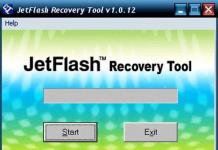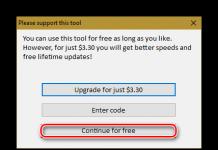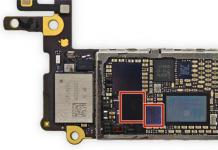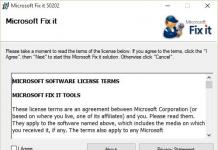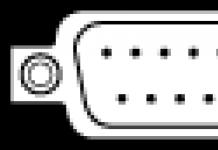Many users resort to the help of the application time machine to create and manage backups or backups. But sooner or later there comes a time when you need to delete old and unnecessary backups to free up disk space. If you're having trouble with this process, we'll walk you through the basic ways to delete Time Machine backups.

The easiest and most obvious way to delete old Time Machine backups is to use the application itself. Make sure you have connected the external drive to your computer first.
1. Launch the Time Machine application.
2. Move to the point in time you want to delete the backup.

3. In the program window, right-click on the desired backup or click on the gear in the Finder window.
4. Select Delete Backups.
5. Confirm your decision by entering the administrator password.
Deleting Time Machine backups using the command line:
The second method, which we will look at today, excludes the use of the Time Machine application. But at the same time, it will require certain knowledge from the user, in particular, the ability to work with the command line. To delete backups, we will use the tmutil command, which instantly deletes backups of any creation period.
Use this command:
tmutil delete /TimeMachine/Drive/Path/To/OldBackup/
In this command, you must specify the exact path to the folder where the backups are stored. In order to simplify the process of finding and deleting old backups, it is best to list them using the ls command.
The command will look like:
ls /Volumes/TimeMachineDrive/Backups.backupdb/MacName/
This list can be quite large. But in it you can find and delete backups by the dates you need. To delete a backup of a specific date, use the following command:
tmutil delete /Volumes/BackupDriveName/Backups.backupdb/MacComputerName/YYYY-MM-DD-HHMMSS/
Where BackupDriveName is the name of the backup drive, MacComputerName is the name of your computer, and YYYY-MM-DD-HHMMSS is the format for the year, month, date and time of the backup.
For example, in our case the command would be:
sudo tmutil delete /Volumes/Time Machine Backups/Backups.backupdb/MacBook\ Pro/2015-07-13-150021/
Using the command line, you can delete any backup or all of them at once. But you need to understand what you are doing and how, otherwise you risk deleting important data. Therefore, use the command line only when you are confident in your abilities.
Time Machine in Lion boasts a useful feature that many often forget about - creating local backups. This feature comes in handy for portable Mac users who save backups to an external hard drive. This article will discuss how to disable and re-enable this feature.
But what is the benefit of local backups? If an external drive is not available, Time Machine will try to make up for this shortcoming and store additional snapshots on the Mac's primary drive. There are obvious advantages to such a system, as you can very quickly revert to previous versions of accidentally deleted .
I don’t think that this approach worries MacBook Pro users with large hard drives, but for owners with solid state drives, such backups can really spoil their nerves - SSD in most cases is small and quickly clogged with various information, but here Time Machine takes up a lot of free space with its own, albeit useful features.
To see the “scale of the tragedy” with your own eyes, just go to the apple menu, select “About this Mac” and click on the “Details” button to display a window with additional information about your computer. After that, you need to go to the "Storage" tab and find the category "Archive" on the chart:

In this case, 30 gigabytes is occupied by local backups - this is more than 12% of the total storage capacity and, in my opinion, quite a lot. To disable this feature, you only need to follow a few simple steps:
1. Go to the Programs > Utilities directory (/Application/Utilities) and run the application.
2. Wait until the program window appears in front of you, and enter the following command:
sudo tmutil disablelocal
3. It remains to enter the password for an account with administrator privileges (in most cases this will be the password for your Mac account), and saving local backups will be disabled, and the treasured gigabytes will be saved.

Naturally, the advice will only be half useful if I do not tell you how to put everything back in place. You will need to follow the same sequence of actions, except that instead of the original command, you need to enter a slightly modified one into Terminal.app:
sudo tmutil enablelocal
It is also worth remembering that if you disable this feature, you will not have any local copies at all. Therefore, if something goes wrong, and the external hard drive is not available, you are out of luck.
Friends, in today's article I will tell you how I deleted iTunes backups and why I did it. The thing is, my computer is running out of free space and when I try or back up my iPad data in iTunes, I get a message about not enough free space:
iTunes was unable to update iPhone "iPhone" due to insufficient free space on this computer.
Deleting files and emptying the Recycle Bin will free up additional space.
Usually, after the appearance of such notifications, the session of creating a backup or updating the iPhone and iPad ends, after which I start deleting unnecessary programs, music and movies from my computer to make room for the insatiable.
But just the other day, faced with a similar problem, I realized that there was nothing to delete from the computer, no matter how much I deleted and emptied the trash, iTunes still did not have enough space. After a little analysis of the contents of the logical drive, it became clear that all the space is occupied by the folders of iTunes itself. It turned out that for several years the iTunes program created backup copies of the iPhone and put everything in its folders. Therefore, we decided to delete iTunes backups from our computer, thus freeing up disk space.
Delete all iTunes backups
If you still don’t know where iTunes stores backup copies of iPhone phones and iPad tablets, then read the instructions - “”. Before we started deleting backups, we determined their total size - on our computer, all backups occupied about 5 gigabytes, so much space will be freed up after deletion.

First, we delete the backups in iTunes Settings, where all devices are backed up. You can’t delete everything at once here, so select and delete one at a time. If you need any copies, please keep them.

It happens that backups are deleted in iTunes settings, but there is still not enough space on the computer, then we go and delete all folders with backups manually. In our Windows XP computer, we go through the following path:
C:\Documents and Settings\iBobr\Application Data\Apple Computer\MobileSync\Backup\
 It is in the Backup folder that all folders with backups made earlier in iTunes are saved, select all folders and delete them. If you are using a different operating system on your computer, then you can see the path for storing your backups at the link above, which describes how to create backups. After deleting the folders, we empty the trash, and our computer gets additional free space.
It is in the Backup folder that all folders with backups made earlier in iTunes are saved, select all folders and delete them. If you are using a different operating system on your computer, then you can see the path for storing your backups at the link above, which describes how to create backups. After deleting the folders, we empty the trash, and our computer gets additional free space.
This instruction can also be useful to those who are from their computer, and there is little space left, in such cases, after uninstalling iTunes, you can delete the entire Apple Computer folder, it happens that it remains after uninstallation.
Periodically backing up the data stored in the memory of the iPhone and iPad before each recovery, update or jailbreak of the device is a necessary procedure. This allows you to protect yourself from losing vital data (phone book, personal photos and videos, notes or calendar) in the event of any failure, software or hardware. Well, when you have a personal computer with iTunes installed, in this case the size of the backup does not matter. But if you actively use iCloud to store important information and content, and the free space in the cloud storage is limited to 5 GB (free), you should think about the up-to-date copy. If the need arises delete backups from iCloud or set up iPhone backup, it is very easy to do this.
The functionality of iOS is enough to set up a very flexible backup of the data stored in the memory of the iPhone or iPad and keep the copy up to date. In some cases, you may need to completely delete the backup copy of the device from the Apple cloud storage, for example, as unnecessary.
The iOS backup control panel is located along the path: “ Settings -> iCloud -> Storage -> Storage -> Chapter Backups“.
You can access this menu only if iCloud is connected to your device, i.e. in " Settings -> iCloud"Your Apple ID is connected.

Each Apple ID holder gets 5 GB free in iCloud. This space can be filled with data from iCloud-enabled apps (Pages, Numbers, VKarmane, 1Password), your own files in iCloud Drive, and copies of data from devices connected to your Apple ID.
If you have several devices "hung" on the same iCloud account and save data there, then the free storage space may run out quickly enough and the question will arise how to delete backups from iCloud and free up space.
Or, suppose you sold another iPhone that was connected to an Apple ID and whose copy was stored in iCloud. Of course, it would be wise to delete the files of this device and thereby make room for other kinds of information. It is very easy to do this from any iOS device connected to your Apple ID.
Delete a backup from iCloud
Connect your iPhone or iPad to the Internet (preferably via Wi-Fi, it will be faster).
Follow the path: “Settings -> iCloud -> Storage -> Storage -> Chapter "Backups" and select the device whose copy you want to delete.
Swipe up to scroll down the page and tap on the inscription “ Delete copy”.

Simultaneously with the removal of the copy, the backup of the device whose data you have deleted will be disabled.

I draw your attention to the fact that the iPhone or iPad iCloud backup function can be controlled from another iOS device connected to the same Apple ID, but just remember to turn it off.
Backup setup
If you can disable backup and delete a device copy remotely from another device, then you can configure copying (enable or disable individual elements) only on the device whose function you are configuring.
To cancel or enable data backup of individual iCloud-enabled programs, just turn off / on the switch opposite the corresponding program in the menu: “ Settings -> iCloud -> Storage -> Storage -> Device backup” and the backup function of its data will be disabled, i.e. when creating a copy of your device, the data of this program will not be added.

This allows you to save free space in iCloud for other data, especially if there are a lot of iCloud-enabled programs (and there are more and more of them) on your device.
As you can see, there is nothing complicated about how to delete an iPhone backup from iCloud, and there are no difficulties in setting up a backup. Before following the steps above, think twice if you really don't need a copy of your device or data in a separate app.
Apple device owners have always had the same problem. It lies in the fact that the space on drive C, with each connection to iTunes, is getting smaller and smaller.
It seems that you can’t refuse backup copies, but what if something happens to the phone. But backups do take up a lot of space, especially if you have multiple devices.
I think it's good to delete old backups from time to time that you definitely don't need anymore.
Therefore, today I will tell you how to find them on your computer.
I know two ways to delete backups:
Deleting via iTunes
iTunes has the option to delete backups. You just have to run it, go Edit — Settings.
Now go to the tab Devices and see a list of our backups. Select the one you want and delete. 
Delete via C drive
As you probably already guessed, you can also delete backups directly. That is, go to the folder where they are stored and delete.
For this we go to Start and click on Username.
Now you see a lot of daddies and we need a folder called AppData. It is not there, because it is hidden so that no one else accidentally wanders into your backups.
To make the folder visible, click on the top streamline — Folder and search options — View — Hidden files and folders — Show hidden files, folders and drives.
If this is difficult to do, then go to the article and there in paragraph Hiding invisible folders everything is described in detail.
After the procedures done, we have a folder AppData.
Next, go to these folders Roaming-Apple Computer-MobileSync-Backup. If you do not have Windows 7, then go to this site, there you will find your operating system -> Folder path. When you go to the destination folder, you see a lot of files.
To understand what exactly to delete, just look at Date of change. Accordingly, if today's date, then the backup was made on the current day.

Conclusion
Delete all files except the last two backups, you never know what can happen.
Perhaps this is all I wanted to talk about.
And I almost forgot, finally I saw a little on this topic:


